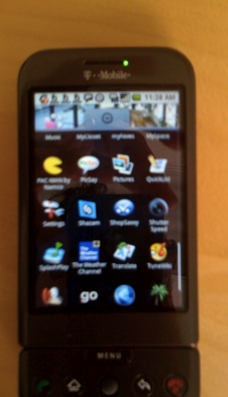
The first Android phone. the G1, goes on sale today at T-Mobile stores. And, although I have some issues with the software/hardware interface, those are more than overcome by all the great software on the phone. I’ve been testing out a phone for about a week, and I don’t think I’ve made more than five actual calls on the phone. For me, it’s all about the apps.
The apps I use the most come with the device: Gmail, the Web browser, and Google Maps, in that order. The phone also comes with the Amazon MP3 store, which lets you buy songs and download them over the air directly onto the phone. But you can also download apps from the Android Market , which is similar to the iPhone’s App Market. Many of the original apps on the review phones have been scrubbed
, which is similar to the iPhone’s App Market. Many of the original apps on the review phones have been scrubbed , and about 50 are supposed to be loaded onto the market for today’s launch.
, and about 50 are supposed to be loaded onto the market for today’s launch.
Right now, I count 40 apps on the market (all of them are free, but paid apps are coming with a 70 percent cut going to developers ), and I know of several that are supposed to launch today that have not yet appeared on the phone. But if you are going to get a phone today, here is my list of the top ten apps worth downloading and checking out.
), and I know of several that are supposed to launch today that have not yet appeared on the phone. But if you are going to get a phone today, here is my list of the top ten apps worth downloading and checking out.
1. imeem Mobile: It’s a jukebox in your pocket, and the progressive download means that your song doesn’t skip when you go into an elevator, ’nuff said.
2. ShopSavvy: From Big in Japan, this turns your phone into a barcode scanner and then gives you price comparisons both online and in nearby retail stores. In my tests, the product database is good for household items, but can stumble with obscure products. But this is a killer app once the product database becomes more comprehensive. (Also try CompareEverywhere, which does the same thing).
3. Pac-Man: The original arcade game from Namco. Free on the Android (it costs $7.99 on the iPhone). The rollerball is an excellent joystick.
4. BreadCrumbz: You can leave photo and voice marker breadcrumbz along any route that others can then follow later on. Ties into the phone’s GPS, maps, camera, and microphone.
5. Wikitude: A travel guide that pulls up information from Wikipedia about nearby locations and puts them on a map, along with photos from Panoramio. Really useful geo-mashup.
6. Shazam: Put the phone up to a radio or speaker playing a song and Shazam will tell you the name and the artist, just like the iPhone app.
7. SplashPlay: Teaches you how to play the guitar by playing music and showing a fret board that you can play on the screen in sync with the music. The app is marketing for a similar tutorial device you can buy for your guitar, but it really teaches you how to play.
8. iSkoot for Skype: Lets you use your Skype account to IM your contacts, make Skype calls over the Internet, and uses the phone for SkypeOut calls (this is one of the apps that was taken down, but should go up again. Update: It’s available now)
9. MyCloset: This one’s more for the ladies, but a very nicely done app. You take apicture of every article of clothes in your closet, categorize them (top, bottom, shoes, accessories, etc.), select months when they can be worn, and then you can mix and match to plan out your outfits. The only thing it needs is some way to note weather a piece of clothing is clean or not.
10. Cab4Me Light: A simple app that gives you phone numbers of cab companies based on where you are.
 This year’s Wikipedia edition for
This year’s Wikipedia edition for 
